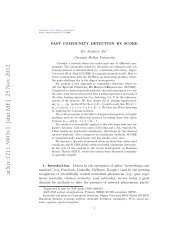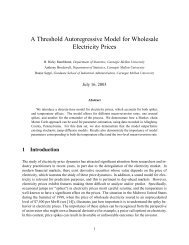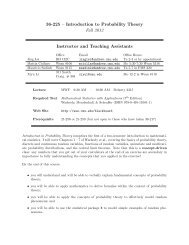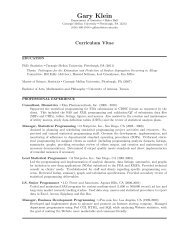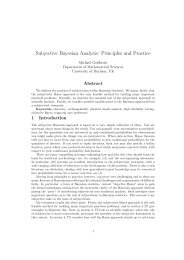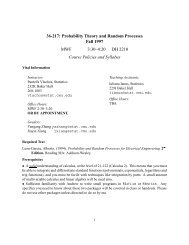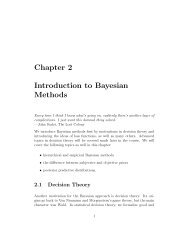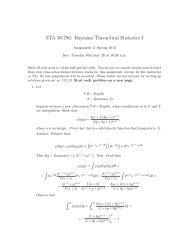STA 36-786: Bayesian Theoretical Statistics I
STA 36-786: Bayesian Theoretical Statistics I
STA 36-786: Bayesian Theoretical Statistics I
Create successful ePaper yourself
Turn your PDF publications into a flip-book with our unique Google optimized e-Paper software.
<strong>STA</strong> <strong>36</strong>-<strong>786</strong>: <strong>Bayesian</strong> <strong>Theoretical</strong> <strong>Statistics</strong> I<br />
Assignment 1: Spring 2013<br />
Due: 1/31/2013 at 10:30 a.m.<br />
Show all your work to obtain full/partial credit. You are not to consult outside sources<br />
other than your class notes/slides for this assignment (except for the instructor or TA). No<br />
late assignments will be accepted. Please follow the instructions for writing up solutions<br />
that were given out in class on 1.12.13.<br />
1. (a) Find the Bayes estimator when the loss function is L(θ, δ(x)) = c (θ − δ(x)) 2 ,<br />
where c is a constant.<br />
(b) Derive the Bayes estimator when L(θ, δ(x)) = w(θ)(g(θ) − δ(x)) 2 . Do so without<br />
writing any integrals. Note that you can write ρ(π, δ(x)) = E[L(θ, δ(x))|X].<br />
Solution: When L(θ, δ) = c(θ − δ) 2 , the Bayes estimator is simply the posterior mean.<br />
When L(θ, δ) = w(θ)(g(θ) − δ(x)) 2 , we want to minimize<br />
ρ = E[w(θ){g(θ) − δ(x)} 2 | X] = E[w(θ){g(θ) 2 + δ(x) 2 − 2δ(x)g(θ)} | X].<br />
Then<br />
∂ρ<br />
E[w(θ)g(θ) | X]<br />
= 2E[w(θ)δ(x) | X] − 2E[w(θ)g(θ) | X] = 0 =⇒ δ(x) =<br />
∂δ(x) E[w(θ) | X]<br />
Then verify that this is indeed a minimum.<br />
2. Consider the decision problem in which Θ = {θ 1 , θ 2 }, A = {a 1 , a 2 , a 3 , a 4 , a 5 }, and the<br />
loss function is given as follows:<br />
L(θ 1 , a 1 ) = 0, L(θ 1 , a 2 ) = 3, L(θ 1 , a 3 ) = 1, L(θ 1 , a 4 ) = 3, L(θ 1 , a 5 ) = 4;<br />
L(θ 2 , a 1 ) = 4, L(θ 2 , a 2 ) = 6, L(θ 2 , a 3 ) = 0, L(θ 2 , a 4 ) = 0, L(θ 2 , a 5 ) = 1.<br />
Consider the prior π under which π(θ 1 ) = 4/5 and π(θ 2 ) = 1/5. Find the Bayes<br />
action(s) under this prior.<br />
Solution: Note that this is a no data decision problem in that we don’t observe X|θ.<br />
Thus, simply find the δ = a i such that E θ [L(θ, a i )] is minimized.<br />
Recall that the posterior risk ρ(π, a i ) = ∑ i L(θ, a i)π(θ i ). Then<br />
ρ(π, a 1 ) = 4/5,<br />
Thus, a 1 and a 3 are Bayes actions.<br />
ρ(π, a 2 ) = 4/5 × 3 + 1/5 × 6 = 18/5,<br />
ρ(π, a 3 ) = 4/5 × 1 = 4/5,<br />
ρ(π, a 4 ) = 4/5 × 3 = 12/5,<br />
ρ(π, a 5 ) = 4/5 × 4 + 1/5 × 1 = 17/5.
3. Suppose that both the parameter space and the action space are the [0, 1] interval and<br />
the loss L(θ, a) = 100(a − θ) 2 . Consider the prior π(θ) = 2θ, 0 ≤ θ ≤ 1.<br />
(a) Show that the Bayes action under the prior π is given by a = 2/3 and that the<br />
corresponding Bayes risk is 50/9.<br />
(b) Next, suppose that one changes the prior to π(θ) = 3θ 2 , 0 ≤ θ ≤ 1, but all else<br />
remains the same. What do you know about the Bayes action under squared<br />
error loss for this prior? What is the Bayes action now?<br />
Solution: Note that this is a no data problem so R(θ, δ) = L(θ, δ). Then<br />
∫<br />
ρ(π, a) = R(θ, δ) π(θ) dθ<br />
= 100<br />
= 200<br />
= 200<br />
∫ 1<br />
0<br />
∫ 1<br />
0<br />
∫ 1<br />
0<br />
(a − θ) 2 2θ dθ<br />
(a − θ) 2 θ dθ<br />
(a 2 − 2θ + θ 2 ) θ dθ<br />
= 200(a 2 /2 − 2a/3 + 1/4).<br />
Then ∂r<br />
∂a = 200(a − 2/3) and ∂2 r<br />
= 200 > 0. Thus, r(π, a) is minimized at a = 2/3.<br />
∂a2 The corresponding Bayes risk is<br />
r(π, 2/3) = 200(2/9 − 4/9 + 1/4) = 200/<strong>36</strong> = 50/9.<br />
Since the weight is constant, the Bayes rule is the same as under squared error loss.<br />
Thus, the Bayes action is E(θ) = ∫ 1<br />
0 2θ2 dθ = 2/3.<br />
Under the other prior, the Bayes action is simply ∫ 1<br />
0 3θ3 dθ = 3/4.<br />
4. Suppose that the parameter space Θ = (θ 1 , θ 2 ) and that the action space A = (a 1 , a 2 ).<br />
Also suppose that<br />
L(θ 1 , a 1 ) = L(θ 2 , a 2 ) = 0; L(θ 1 , a 2 ) = 5, L(θ 2 , a 1 ) = 10.<br />
The statistician observes a random variable X such that conditional on θ = θ 1 ,<br />
X ∼ N(0, 1), and conditional on θ = θ 2 , X ∼ N(1, 1). Now consider the prior<br />
under which P (θ = θ 1 ) = η. Show that the Bayes rule under this prior is to take<br />
action a 1 if and only if<br />
x ≤ 1 2 + log η<br />
2(1 − η) .<br />
Solution: Consider<br />
p(θ = θ 1 |x) =<br />
p(x|θ 1 )p(θ = θ 1 )<br />
p(x|θ 1 )p(θ = θ 1 ) + p(x|θ 2 )p(θ = θ 2 )<br />
= 1 − p(θ = θ 2 |x).<br />
2
Now the posterior risk under action a 1 is<br />
L(θ 1 , a 1 ) p(θ = θ 1 |x) + L(θ 2 , a 1 ) p(θ = θ 2 |x) = 10 p(θ = θ 2 |x)<br />
while the posterior risk under action a 2 is<br />
L(θ 1 , a 2 ) p(θ = θ 1 |x) + L(θ 2 , a 2 ) p(θ = θ 2 |x) = 5 p(θ = θ 1 |x).<br />
Hence, a 1 is preferred to a 2 if and only if<br />
This implies<br />
10 p(θ = θ 2 |x) ≤ 5 p(θ = θ 1 |x).<br />
p(x|θ 2 ) p(θ = θ 2 ) ≤ (1/2) p(x|θ 1 ) p(θ = θ 1 ) =⇒<br />
1<br />
(1 − η) √ e −1/2(x−1)2 ≤ η 1<br />
√ e −1/2(x)2 =⇒<br />
2π 2 2π<br />
e x−1/2 η<br />
≤<br />
2(1 − η) =⇒<br />
x ≤ 1/2 + log<br />
η<br />
2(1 − η) .<br />
3



